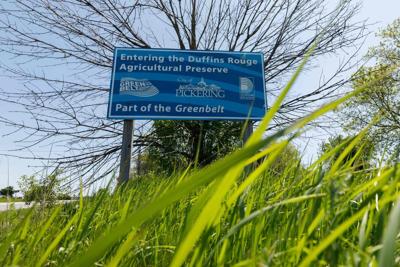The long-term solution for orderly urban growth is to develop a comprehensive plan for all the land south of Georgian Bay/Algonquin Park.
By David Collenette Contributor
Wednesday, September 6, 2023
A sign is seen at the entrance to Duffins Rouge Agricultural Preserve, a part of the Ontario Green Belt in the Greater Toronto Area of Pickering, Ontario, Canada, on May 25.
COLE BURSTON / AFP via GETTY IMAGES
Ontario Liberals are engaged in electing a new leader from a list of very impressive candidates. Policy discussion is front and centre in candidate debates and chatter among Liberals.
Defence of the world’s largest urban Greenbelt around the Greater Toronto Area, the envy of cities around the globe and established by the Liberal government 15 years ago, has emerged as a
sine qua non, not only for a sustainable environment, but also for orderly land use planning and efficient transportation.
The current political crisis at Queen’s Park reflects an undermining of the Greenbelt’s integrity by allowing access to select developers in the name of increasing housing supply. It underscores an irrefutable reality — woe betide any politician to even hint about tinkering with this crucial piece of environmental protection.
While reputable studies show there is enough available land in the GTA to meet new housing targets, this will not be the case if the high immigration levels of the past few years are sustained. The long-term solution for orderly urban growth is to develop a comprehensive plan for southern Ontario, including all the land south of Georgian Bay/Algonquin Park. A key determinant of the policy would be transportation priorities.
Transportation is often taken for granted by most Canadians, but when the supply chain is interrupted affecting the delivery of food, goods, and essential services; when a municipal transit system
like the Ottawa LRT consistently fails to work; when ports are shut down by industrial action; when major rail lines are blocked by accidents, wildfires and deteriorating infrastructure; or when new highways and transit systems are proposed in sensitive urban and rural settings, only then do people wake up and become vocal.
While there needs to be consistent upgrading of highways, adding extra capacity where necessary, as the population grows there will be increased pressure to build land-gobbling motorways, like the proposed Highway 413 and the
Bradford By-Pass, both to be constructed through some of the most fertile agricultural land in North America. This must be vigorously resisted.
We can see the result of blindly following a rampant motorway policy every time we drive on Highway 401, which has become a conveyor belt for tens of thousands of trucks daily, with passenger vehicles crawling along at glacial speeds. Before embarking on
a questionable project like the Highway 413, the Ontario government needs to address the underutilized Highway 407, built by the province, then sold to the private sector for a pittance, including an outrageous 99-year operating lease.
Surely it would be cheaper, more efficient and environmentally more sustainable if the province incentivized commercial trucking companies to use the 407. Such a scheme would be more palatable now that the 407 ETR is 507 per cent owned by the Canada Pension Plan Investment Board.
Highways must be viewed primarily as a distribution mechanism for the movement of goods and people, not solely as a trunk conveyor. This should be the role of railways. Ontario is awash in railway corridors, some underutilized and many long abandoned that could be resuscitated to provide alternate transportation for people and goods.
Ontario’s Metrolinx is overseeing significant expansion and electrification but more needs to be done so communities with existing rail service, whether operated by GO or VIA, can be connected more efficiently with major cities like Toronto, Ottawa, Hamilton, London, and Windsor.
Cities outside the Greenbelt, where passenger rail was abandoned decades ago, like Peterborough and Lindsay, should see reinstatement of services. This would incentivize developers to build much needed housing in those cities, as well as smaller communities along the rail corridor and provide economic stimulus to those municipalities as the population increases. Thought should also be given to establishing “GO Transit East” in the Ottawa area to replicate the success of commuter rail in the GTA.
Ontario leadership candidates need to address these issues. Voters have a right to know the direction of a future Liberal government. The purpose of the Greenbelt was to prevent urban sprawl, while at the same time preserving vast tracts of agricultural and recreational land. This has been achieved. Let’s build on its success, not throw away an outstanding policy that is universally admired.
David Collenette was a Toronto MP, Minister of Transport and Minister Responsible for the GTA (1997-2003).





